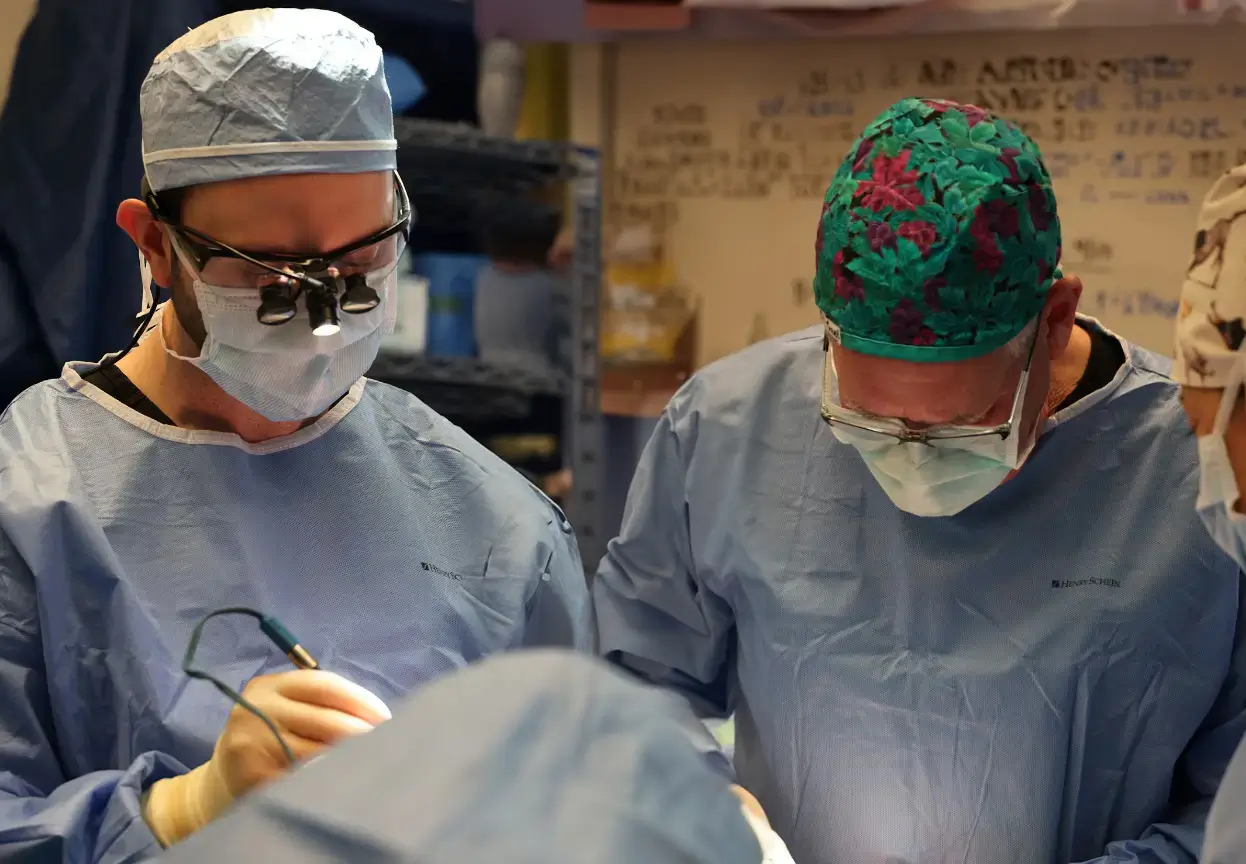
This well-proven and revolutionary surgical procedure helps define your chin and neck contour better than anything else. Other types of neck lifts involve addressing the skin, superficial fat, and platysma muscle. Those types of techniques are great for helping with neck laxity, platysmal banding, and jowls but can come short when addressing the double chin and stubborn neck fat. Only the deep neck lift technique addresses the underlying deep fat underneath the platysma muscle.
The deep neck lift technique allows Dr. Bovenzi to contour your cervicomental angle. This change can make the difference between someone that looks like they have a weak chin and “no neck” to someone with a strong neckline, jawline, and stronger chin. The deep necklift technique is an advanced technique that has grown in popularity over the past few years as people worldwide are noticing the benefits of this surgery.
Dr. Bovenzi understands the importance of restoring a youthful and graceful appearance to the neck and face. As a specialist in Denver facial plastic surgery, he regularly creates incredible deep neck lift results for patients at Smith Cosmetic Surgery & Medical Aesthetic Center. Call (303) 732-5595 today or fill out our contact form to arrange your complimentary consultation with Dr. Bovenzi.
View this post on Instagram
Liposuction is a targeted method of removing stubborn fat from areas of the body. It involves insertion of a cannula (a small tube with a blunt end) and application of vacuum suction to take out fat cells.
Previously, patients with excess fat under their chin would be treated with liposuction alone, but many of these patients actually have stubborn fat that is in the deep plane underneath the muscle that cannot be treated with liposuction alone. This fat is resistant to exercise and often contributes to a double chin.
The deep necklift technique has allowed these patients to achieve a neck contour they always dreamed of! During a deep neck lift in Denver, fat is removed from both the superficial plane and the deep plane. Because of this, it is a more powerful fat-reduction technique than standard chin liposuction.
Most commonly, patients that have anatomy amenable to a deep neck lift procedure have had a weak neckline for their whole lives- the deep neck fat has a large genetic component as opposed to the superficial fat treated with liposuction that has more capacity to change with weight gain or loss.
Additionally, deep necklift candidates can be of almost any adult age- while traditional necklift techniques are focused on the aging process, deep necklift surgery has the potential to help both younger and older patients that suffer from a weak neckline (aka an oblique cervicomental angle).

Rather than performing a one-size-fits-all necklift, Dr. Cory Bovenzi focuses on each patient’s unique neck anatomy to create customized results that address their goals. Unlike other surgeons, he adjusts deep structures in the neck to effectively reduce a double chin.
Dr. Bovenzi’s mastery of state-of-the-art techniques sets him apart from other plastic surgeons. He employs cutting-edge technology and is always learning more about new advances in the field of facial plastic surgery. These advances allow him to ensure a more comfortable recovery process for patients.
To minimize post-surgical bruising, Dr. Bovenzi utilizes TXA (tranexamic acid) in deep necklift procedures. His approach involves a surgical sealant called Artiss, which makes it so no post-surgical drains need to be placed. Dr. Bovenzi’s bespoke technique greatly minimizes the chance of complications affecting the nerves or the salivary glands.
Unlike most plastic and cosmetic surgeons, Dr. Bovenzi is board-certified in otolaryngology (head and neck surgery). This certification makes him uniquely qualified to perform deep neck lifts. After performing over 5,000 facial procedures, he is the go-to surgeon for even the most complex cases.
He performs all of his deep neck lifts at our Denver facility, which is conveniently located near Centennial Airport. Our facility boasts a cutting-edge surgical suite equipped with the highest-caliber medical technology. Accredited by the Accreditation Association for Ambulatory Health Care, this suite offers the utmost privacy and safety for deep neck lift patients.
Dr. Bovenzi has always had a natural affinity for medicine. At Sidney Kimmel Medical College of Thomas Jefferson Hospital, he completed his doctorate, graduating in the top 1% of his class.
After a residency at Thomas Jefferson Hospital, he delved further into the world of facial surgery, completing a facial plastic and reconstructive surgery fellowship at the Emory University School of Medicine. Fellowships like these are highly competitive, and only around 55 openings are available in America every year.
Dr. Bovenzi has given numerous lectures and presentations at national conferences and conventions, and he has written several medical journal articles. He has privileges at Porter Adventist Hospital in Denver, CO, and Littleton Adventist Hospital in Littleton, CO.

Dr. Bovenzi offers free deep neck lift consultations at our Denver facility, not far from South Suburban Golf Course and the Holly Park Pool and Tennis Center. During your personalized consultation, Dr. Bovenzi will ask you about your cosmetic goals in great detail. He will then examine your neck and face, taking measurements as needed.
Dr. Bovenzi will ask you questions about past procedures, current medications, and allergies. He will also order evaluative blood work. Next, he will walk you through the details of your custom-tailored neck lift and answer any questions you may have.

Dr. Bovenzi will advise you regarding the best ways to prepare for your deep neck lift surgery in Denver. This will include avoiding non-steroidal anti-inflammatory drugs, smoking, and alcohol. You’ll also need to arrange time off from work and set up a well-stocked recovery area at home.
On the date of the operation, you’ll come to our facility, not far from scenic and beautiful Cherry Creek State Park. You’ll meet with Dr. Bovenzi and will then be prepped for your deep neck lift.
“Deep neck lift surgery differs from traditional neck lift surgery in the underlying anatomy that you’re trying to treat.” explains Dr. Bovenzi. Under the skin lies the superficial fat layer. Beneath that lies the platysma muscle. Underneath this muscle is the deep neck fat.
In a traditional neck lift, only the platysma muscle, excess skin, and superficial fat are being treated. “With liposuction under the chin, you’re really just addressing this superficial fat,” he adds.
Only a deep neck lift can address the excess deep neck fat. During the procedure, Dr. Bovenzi creates a single incision under the chin and then goes beneath the platysma muscle to remove deep fat.
“When I take out that extra fat underneath there, I’ll sew up the muscle to a [tighter] angle and bring it back up,” says Dr. Bovenzi. He also removes excess superficial fat when necessary.
Before surgery, with typical deep neck lift patients, the neck has an oblique cervicomental angle, and after, it’s usually much closer to a 90-degree angle. Dr. Bovenzi can create subtle or dramatic improvements depending on each patient’s goals.
Additionally, Dr. Bovenzi can draw upon his years of experience to pair a deep neck lift with other facial plastic surgery procedures, such as chin augmentation. By inserting a chin implant through the same hidden incision used for the deep neck lift, he can enhance chin projection, improving jawline and neckline definition.

The recovery from a deep necklift takes approximately 2 weeks for bruising to fade and for the lion’s share of the swelling to resolve1. The surgery itself is done under twilight anesthesia and takes about 2 hours. You are able to go home the same day.
In the vast majority of cases, you do not need any drains, and just need to wear an ace wrap to help with some pressure under your chin for the first week after surgery. A large padded dressing of gauze is placed the day of surgery and is removed on your first postoperative visit the following morning, replaced by a small ACE wrap.
There is a small incision under your chin that is well-hidden. The sutures at the incision are removed 1 week after surgery. To take care of the incision, we recommend using cotton swabs dipped in half-strength hydrogen peroxide to clean the suture site and afterwards apply ointment to keep the incision moist as this helps the incision heal to become as invisible as possible.
The main restriction after a deep necklift surgery is to avoid strenuous exercise for about 3 weeks to allow your neck muscle and skin to heal properly. Most patients return to in-person work in 1 to 2 weeks after surgery, but it is possible that you could work from home or do computer-based work after just a few days.
If you think you may be a candidate for a deep necklift or have more questions about the procedure, please reach out and set up a complimentary consultation with Dr. Bovenzi.
1 Bovenzi, Cory & Daraei, Paul & DeJoseph, Louis. (2022). Tranexamic Acid Use in Rhytidectomy: A Systematic Review of the Literature and Future Directions.
While standard necklifts often involve removal of excess neck skin, this step is not typically required during a deep necklift. The skin between the lower neck and the bottom of the chin is somewhat straight. During the deep necklift process, this skin is redraped closer to a 90-degree angle. Redraping this skin stretches it, reducing laxity and making the neck skin firmer.
In standard necklifts, surgeons sometimes need to create incisions below the chin and behind the ears. Since performing a deep necklift for Denver patients does not require excess skin removal, Dr. Bovenzi typically does not need to make incisions behind the ears.
People notice signs of neck aging at a younger age than in most other regions. This occurs because of two factors. First, the skin of the neck is thinner than the skin in many other areas of the body. Second, the neck skin doesn’t have as many oil glands, resulting in a faster decline in elasticity.
Signs of aging may appear on the neck around age 35, and most people start to notice them anywhere from ages 40 to 60. Because of this, the average range for necklift patients is between 35 and 65.
In a person’s 50s, signs of aging often become more prominent. During this time, they are most likely to come in for a necklift. The degree of skin elasticity present at this time is typically still high enough to make these patients excellent candidates for surgery.
However, there really is no specific age limit for necklifts. Dr. Bovenzi specializes in achieving optimal results for patients of all ages and employs different techniques depending on the patient’s age.
Younger patients may not have skin laxity but may still have a double chin. In these cases, Dr. Bovenzi’s deep necklift is an ideal solution, since it addresses the deep-plane fat responsible for a double chin that cannot be fully treated any other way.
A neck lift in Denver is able to smooth away neck wrinkles, creating a more youthful appearance for the neck. It achieves this through tightening of loose neck skin that has lost elasticity.
Benefits of neck lift surgery in Denver include tightening of lax skin, removal of neck fat, and tightening of sagging muscles. These changes can reduce a double chin, treat a turkey-wattle neck, create a gracefully contoured neck, and reduce signs of aging like neck bands and wrinkles.
Another benefit is the procedure’s long-lasting results. The changes achieved during the surgery typically last about 10 years. Since the aging process will continue, new signs of aging will appear over time. However, the benefits of the surgery can still be seen, and aging signs will be nowhere near as prominent.